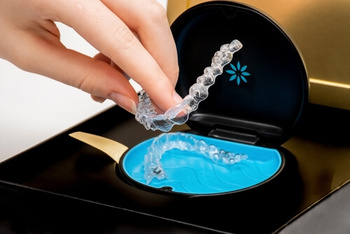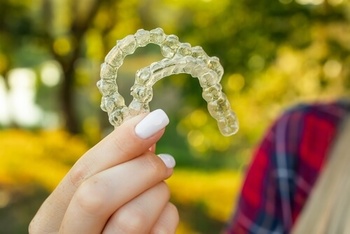
- Harris Dental Boutique
- invisible braces, orthodontics
- Braces | Clear Aligners
A straighter smile can transform both confidence and oral health, but the path to achieving it depends on the treatment choice. Some prefer a nearly invisible solution, while others need a more structured approach to correcting complex misalignment. With advancements in dental care, clear aligners vs braces remain two of the most effective options. While both work toward the same goal, their differences in comfort, aesthetics, and lifestyle impact make the decision more personal. Understanding what sets them apart helps in selecting the right fit based on individual needs. So, which one is the better match for you?
Clear Aligners vs Braces: Understanding the Key Differences
Comparing Aesthetics and Comfort
One of the main differences between clear aligners and traditional braces is their appearance. Many patients prefer an option that is less noticeable, especially when undergoing long-term treatment. Clear aligners offer a nearly invisible solution, making them appealing to individuals looking for a discreet approach. In contrast, traditional braces rely on metal brackets, which are visible when speaking or smiling. This difference often influences a person’s decision, particularly for adults seeking a more subtle treatment.
Comfort is another factor that separates the two options. Clear aligners are made with smooth edges, minimising irritation to the inner cheeks and gums. They are also removable, allowing patients to eat and clean their teeth without obstructions. Braces, however, are fixed in place and may initially cause some discomfort due to wires and brackets. While both options require an adjustment period, aligners tend to provide a more comfortable experience for daily wear.
Maintenance and Oral Hygiene Considerations

Keeping up with oral hygiene throughout orthodontic treatment helps reduce the chance of cavities and gum problems. Braces require extra care, as food particles can get trapped around brackets and wires. Patients must use interdental brushes or floss threaders to clean hard-to-reach areas, making daily hygiene more time-consuming. Consistent dental checkups are also important to monitor oral health throughout treatment.
Clear aligners, on the other hand, offer a more convenient approach to hygiene. Since they are removable, brushing and flossing can be done as usual without any additional tools. However, aligners must be cleaned consistently to avoid bacterial buildup. Patients should rinse them after meals and use cleaning solutions to maintain their clarity. Regardless of the chosen method, maintaining good hygiene habits ensures healthier teeth during and after treatment.
Treatment Duration and Effectiveness
The treatment duration varies depending on the complexity of the case and the chosen method. Braces are often recommended for more severe misalignment, meaning they may need to be worn for a longer period. On average, treatment with braces lasts between 18 months to three years as they gradually shift teeth into position. However, they are highly effective in addressing bite issues and complex dental movements.
For those needing mild to moderate corrections, clear aligners may offer a quicker treatment time, typically ranging from 12 to 18 months with proper use. Follow-up appointments are required for both options—braces require periodic adjustments, while aligners involve switching to a new set every few weeks. The effectiveness of either treatment depends on the patient’s dental needs and commitment to the process.
Suitability Based on Individual Needs
Choosing between Invisalign treatment and braces depends on the severity of misalignment and personal preferences. Braces are generally more suitable for individuals with significant bite issues, crowding, or complex tooth movements. Since they remain fixed, they provide continuous pressure, ensuring that progress is maintained without patient involvement.
Those looking for a flexible solution to minor or moderate misalignment may find clear aligners to be a suitable choice. Since they can be removed, they allow patients to maintain their regular lifestyle with fewer restrictions. However, a dentist’s evaluation is necessary to determine the most appropriate solution. Each person’s dental structure is unique, and professional guidance ensures that the chosen method aligns with their specific needs.
Patient Compliance and Lifestyle Considerations
Patient compliance plays a crucial part in the success of orthodontic treatment. Those using clear aligners must commit to wearing them for at least 20 to 22 hours per day to achieve the expected results. Since they can be removed, there is a risk of patients forgetting to wear them consistently, which may delay progress.
Braces, on the other hand, do not rely on patient compliance in the same way. Once they are placed, they work continuously without requiring any additional effort. However, lifestyle adjustments may be necessary, especially regarding diet. Certain foods, such as sticky or hard snacks, should be avoided to prevent damage. Whether choosing braces or aligners, following the recommended guidelines ensures the treatment is as effective as possible.
Cost and Affordability
The Invisalign vs braces debate often includes cost as a key factor. Traditional braces are generally more affordable upfront, as they use metal components that require fewer customisations. However, long-term costs may vary depending on adjustments, repairs, and maintenance throughout the treatment.
Clear aligners tend to be priced higher due to their customised trays and advanced digital planning. The final cost depends on the complexity of the case, the number of aligners required, and additional follow-up appointments. In some cases, dental or medical condition coverage may provide partial assistance for either option. Patients should consider long-term financial factors when deciding, ensuring they choose a method that suits their budget and needs.
Making the Right Choice
Both braces and clear aligners provide effective solutions for teeth straightening, but the decision depends on lifestyle, comfort, and individual dental concerns. While traditional braces are effective for significant misalignment, clear aligners offer a discreet and flexible alternative. Consulting a professional allows patients to understand which option aligns with their dental health goals, ensuring a confident and successful outcome.
How Do Clear Aligners and Braces Work?
Orthodontic treatment plays a crucial part in correcting misalignment, improving bite function, and enhancing overall dental health. While different methods are available, the way they function varies significantly.
The Mechanism Behind Braces
Braces use a system of brackets and wires to apply continuous pressure, guiding teeth into their correct positions over time. Each bracket is securely bonded to the surface of a tooth, with an archwire connecting them to provide the necessary force for movement. As adjustments are made during regular checkups, the tension in the wire gradually shifts the teeth into alignment. Elastic bands or additional components may be added to correct bite discrepancies or improve positioning. The controlled movement encourages bone remodelling, ensuring that teeth stay in place once they have been repositioned.
How Clear Aligners Shift Teeth
Unlike braces, clear aligners use a series of custom-made trays designed to fit snugly over the teeth. These trays apply gentle yet consistent pressure to encourage gradual movement without the need for brackets or wires. Each aligner is worn for a designated time before progressing to the next one in the series. The shape of each tray is slightly adjusted to promote further tooth repositioning. Over time, this step-by-step adjustment leads to improved alignment, allowing patients to achieve their desired results.
Customisation and Fitting Process
For both treatment options, a detailed digital scan or impression of the teeth is taken to create a personalised plan. With braces, the brackets are precisely placed to ensure accurate movement, while for aligners, the scanned data is used to design a set of trays that match the patient’s dental structure. The design process considers how each tooth needs to move, ensuring an effective and predictable outcome. Invisalign aligners, in particular, are designed with precision, allowing for a treatment approach tailored to individual needs.
Adjustments and Progression
With traditional braces, scheduled visits are necessary to make incremental changes that encourage tooth movement. Wires may be tightened or replaced to maintain the necessary level of pressure. In contrast, those wearing aligners switch to a new set at predetermined intervals, following a planned sequence to achieve the intended alignment. Both approaches rely on controlled force to shift teeth while ensuring the supporting bone adapts to the changes. The gradual process is monitored closely to achieve the desired alignment while minimising unnecessary strain.
Final Stages of Treatment
As teeth reach their final positions, the treatment is completed with retention to prevent them from shifting back. A customised retainer is provided to maintain the results and allow the bone structure to stabilise. Whether a patient has used braces or opted for Invisalign braces, the retention phase plays a critical part in ensuring the long-term success of the alignment process. Regular follow-ups help assess stability and make adjustments if necessary, ensuring that the newly aligned teeth remain in place.
Understanding the Different Types of Braces
Braces remain a widely used option for correcting dental misalignment and bite concerns. Over the years, advancements in orthodontics have introduced several types of braces, each designed to cater to different needs. While all braces serve the purpose of guiding teeth into a more aligned position, the choice often depends on factors such as visibility, comfort, and treatment complexity. Whether someone prefers a more discreet option or requires a sturdy approach for significant corrections, there are various choices available.
Traditional Metal Braces: A Reliable Choice

Among the most common orthodontic treatments, traditional metal braces include metal brackets on each tooth, joined by wires and stabilised with elastic bands. These braces gradually shift teeth into their correct positions using controlled pressure. Their durability makes them suitable for addressing moderate to severe misalignment, overcrowding, and bite irregularities.
One reason metal braces are widely used is their efficiency in handling complex cases. Since they are permanently fixed, they provide continuous correction without requiring patient compliance, apart from regular checkups. Despite their noticeable appearance, they remain a trusted choice due to their effectiveness. For individuals who want a touch of personalisation, coloured elastics can be added, making the treatment process more engaging.
Ceramic Braces: A Less Noticeable Option
Ceramic braces work similarly to traditional metal braces but offer a more discreet look. The brackets are made from a tooth-coloured material that blends with natural teeth, making them less visible. This feature makes them appealing to those who prefer a more subtle approach while still benefiting from the effectiveness of braces.
While ceramic braces are designed to be more aesthetically pleasing, they do require additional care. The material is more delicate than metal, meaning it may be more prone to damage if exposed to excessive force. Additionally, they may require more frequent adjustments since they do not exert as much pressure as metal brackets. However, for patients looking for a balance between effectiveness and discretion, ceramic braces can be a suitable choice.
Lingual Braces: Hidden from View
For individuals looking for an option that is entirely hidden, lingual braces provide a unique alternative. Unlike traditional or ceramic braces, these braces are attached to the back of the teeth, making them invisible from the front. They function in the same way as standard braces but remain hidden from sight, making them a popular choice among those who prefer a more discreet treatment.
Although lingual braces offer an aesthetic advantage, they require an adjustment period. Since the brackets sit behind the teeth, they may initially feel unfamiliar with the tongue, potentially affecting speech and comfort. Maintaining oral hygiene can also require extra effort due to their positioning. However, for those prioritising a hidden orthodontic solution, lingual braces offer an effective way to straighten teeth without the visibility of traditional options.
Comparing Effectiveness, Comfort, and Visibility

Each type of brace offers unique benefits, and the choice largely depends on the individual’s dental needs and preferences. Traditional metal braces are known for their ability to manage even the most complex cases, making them a practical solution for many. Ceramic braces provide a more discreet alternative while still offering reliable results. Lingual braces stand out for their invisible placement, catering to individuals who prioritise appearance.
When it comes to comfort, metal braces and ceramic braces function similarly, though ceramic materials may cause slightly less irritation. Lingual braces, while effective, may require a longer adaptation period. In terms of visibility, ceramic and lingual braces provide a less noticeable approach compared to metal braces. Each option comes with its own considerations, making it essential for patients to consult with their dentist to determine the most suitable choice.
Start Your Transformation with a Consultation
Choosing between clear aligners and braces is a significant decision that impacts both appearance and dental health. Each option provides unique benefits, from the discreet nature of aligners to the comprehensive correction offered by braces. Whether prioritising flexibility or seeking a fixed treatment, achieving a well-aligned smile is possible with professional guidance. Maintaining dental hygiene throughout the process ensures lasting results and prevents unnecessary complications. If you’re considering teeth straightening and need to decide whether to wear braces or opt for aligners, now is the time to explore your options with expert support. Please call us at 07 4158 5813 to book your consultation today.
References
https://www.colgate.com/en-in/oral-health/adult-orthodontics/what-do-invisalign-braces-cost-are-they-worth-it-0113
https://pubmed.ncbi.nlm.nih.gov/30264270





